Basketball Defense - Transition Defense
By Dr. James Gels, from the Coach’s Clipboard Basketball Playbook"As coaches we talk about two things: offense and defense. There is a third phase we neglect, which is more important. It's conversion from offense to defense and defense to offense." — Bobby Knight
"Transition" refers to the process of changing from defense to offense (transition offense), or offense to defense (transition defense). Transition defense can be as simple as having one guard protecting back after a score, rebound or steal, with the rest of the team hustling back on defense. Or if the opponent is a fast-breaking team, it may require two guards back (see below). Or transition defense may employ a full court press defense.
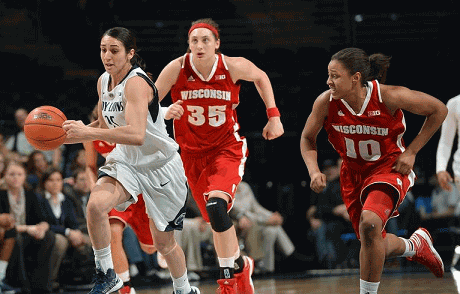
Preventing the fast break
The goal is to prevent the opponent from scoring easy lay-ups on the break. When your team shoots, at least one guard, instead of rebounding, should stay back beyond the three-point arc. This "safety" responsibility should be assigned to a certain player.When a substitute comes in for this player, the sub must know that this is now his/her responsibility. If this player drives to the hoop, there must be an understanding that a second guard will now have this safety responsibility.
As the guard retreats to stop the break, the other four teammates sprint down quickly to defend. Players who fail to sprint back on defense usually find themselves on the bench. There is no excuse for not sprinting back on defense, unless it is fatigue and you need a rest.
In regard to sprinting back, it's the first two steps that really make the difference. Often players hesistate, look and then go. They should be taught to react NOW, with two quick first steps. Game film is a great tool here. Players often think they are sprinting back, until you show them the film.
Two-guards back
Some teams fast-break every time they get the ball. To stop this team, consider having two guards back (diagram A).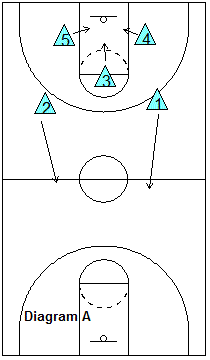
When the shot goes up, the three "big-men" crash the offensive boards, while two guards retreat to the mid-court line, one on each side of the center circle. The guard on the ball-side will pick up the dribbler and try to stop the ball. The other guard retreats back to the opponent's paint area to prevent the lay-up.
When the opponent gets the rebound, our nearest rebounder should try to "jam" and pressure the rebounder in order to slow down the outlet pass. The other two players should sprint back on defense.
Getting back and defending the paint area.
All players sprint back on defense. The first player back should run to the rim and take one step out. His/her job is to defend the hoop and make the offense pass at least once.For youth teams, keep things simple, and have them all sprint back to the paint, and then match up from there. Nowadays the 3-point shot in transition is a big weapon. For high school teams and above, we teach the following:
First, stop the ball. The second player back should stop the ball, no matter where it is. Instead of sprinting to the paint and then stopping the ball, the second player should find the ball wherever it is (even if it is just over the half-court line) and stop it. Even if the offensive player gets by him in the open court, he will have slowed the ball down some, giving our other defenders a second or two to catch up.
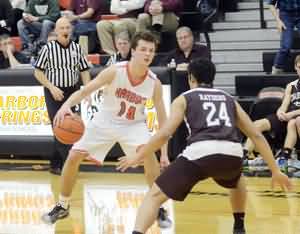
Defending against 2-on-1 and 3-on-2 fast break attacks.
With the opponent running a fast-break, your defense may be confronted with a 2-on-1, or 3-on-2 situation. In these situations, your defense should be taught to first prevent the lay-up. We have a standard rule: "get as low (to the baseline) as the lowest offensive player." This means that if the offense has a player under the basket, a defender must be down low. In a 2-on-1, get right under the basket and stay there. Fake at the ball and recover to try to get him/her to pass or pull up.If the opponent chooses to shoot the outside jumper, give it to them. It is a lower percentage shot than a lay-up, you avoid getting a foul, you may get the rebound, or delay the offense long enough for your teammates to arrive on defense. Often I see a high school player make the mistake of coming up away from the basket and challenging the ball, only to get beaten by a pass to the player under the basket for a lay-up (see diagram). The defender must stay back and "gap" the offensive players, that is, try to straddle and cut off the passing lanes to the easy lay-up.
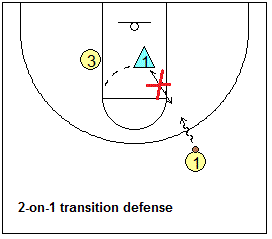
3-on-2 defense
See the diagrams below. When we have a 3-on-2 situation, we stack the two defenders as shown. The top defender stops the ball and yells "ball, ball, ball!" The bottom defender sprints out and takes whoever gets the first pass. As the pass is made, the top defender then immediately drops back in the paint, following the rule "get as low as the lowest offensive player".If you make them pass a couple times, you will delay their break, giving your sprinting teammates a couple seconds to get back to help. We drill the 3-on-2 defense when running the 11-man or 7-man drills, and the 4-on-4-on-4 drill.
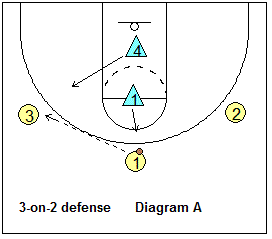


Using the above strategies, sprinting back, and understanding transition defensive assignments, you will go a long way in stopping, or slowing down the fast-break.
Full-Court Press Defense
Transition defense can be even more sophisticated with a full-court pressing defense. The disadvantages of a press defense are that is takes up practice time to develop a good, cohesive press. Also, the full-court press is a gamble (especially trapping defenses). You risk giving up the easy transition lay-up. Good offensive teams with good ball handlers and passers can break the press and turn it into their advantage with an easy score.If you press the entire game, your players may become fatigued, may get into foul trouble, and the offense often "figures it out" with time. You might want to press only in certain situations (e.g. after a made basket), or certain times of the game. You may want to use the press as a surprise tactic.
The advantages are that a good press can quickly produce back-court turnovers, easy steals and easy baskets for your team. So it is an offensive weapon as such, and a way to help you come from behind, or a way to break open a close game. The press keeps the opponent off-balance, changes the tempo of the game, and often has the opponent doing things they don't normally like to do.
It often forces the opposing coach to use valuable time-outs. It favors a well-conditioned team with a deep bench, and with more substitutions, allows more of your players to get playing time. There is a saying, "To error is human, and pressure causes error."
Some basic principles apply to all presses.
1. Have a safety back.
Always have one player back in prevent mode to stop the easy lay-up.2. Sprint back.
Sprint back when you are beaten.3. Avoid back-court fouls.
When trying to stop the dribbler, don't reach-in or "ride" the dribbler. Move your feet and force the ball to the sideline. Back-court fouls are stupid fouls, created far away from the basket where there is no threat to score. It's especially stupid if the opponent is in the two-shot bonus, or if it is committed with only seconds remaining in a period.4. Trapping
In trapping, one defender contains and stops the dribbler along the sideline or baseline, in one of the "trapping zones" (see below). Trapping zones are those areas where we can squeeze the offensive player against the sideline and half-court line (or endline).Once the ball is stopped, the second defender sprints over and double-teams the ball. They cut off the ball-handler's view, and get into the passing lane. The position of their hands should mirror the height of the ball. If the offensive player holds the ball high to throw over the top, the defenders' hands should be high. If the ball is low, the hands should be low to prevent the bounce pass.
The defensive players should be close together ("knee-to-knee") so the offensive player cannot split the trap with a dribble.
Do not reach-in! This changes a good situation into a bad one - now the player goes to the free throw line. Instead, the trapping defenders should try for a 5-second call, or force a turnover or a bad pass and interception.
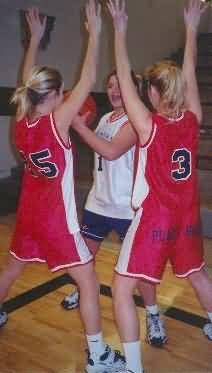
5. Gapping
The other defenders who are not trapping, get into the gaps between the ball-handler and his/her teammates. They play the passing lanes and deny and intercept passes from the trapped player.The yellow zones catch the player in the corner.
The red zones are excellent trapping zones, since the offensive player cannot retreat across the 10 second line.
The blue zones are good trapping zones because the offense has to worry about the 10-second count.
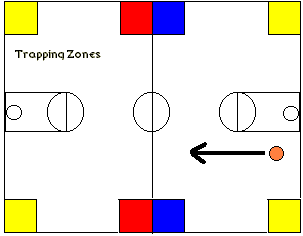
Types of full court presses
Often a pressing team will use more than one type of press. When the offense calls a time-out and makes adjustments to your press, you can change to another type of press. Or you can make simple adjustments of your own, such as whether to guard the inbounds passer or not, whether to deny the inbounds pass with full-denial defense, or allow the inbounds pass to the corner, and then trap it.There are many type of presses. Our high school team has been successful over the years with the match-up press and it's various adjustments. This takes a lot of practice time and we start teaching it when they are freshmen. Many teams use a zone press, which is generally easier to teach. Check these links.
Press Defenses:
- Full-Court Pressure Defense
- Full-Court Match-up Press Defense
- Run and Jump Press Press
- 1-2-1-1 (Diamond) Zone Press
- 2-2-1 Zone Press
- 1-2-2 Zone Press
- 3-1-1 Zone Press
- 1-1-2-1 Press
Drills:
- 2-on-1 Continuous Transition Drill
- 11-Man or 7-Man Drills
- 4-on-4-on-4 Drill
- Rebound-Outlet-Break Drill
- 4-on-4 Transition Drill
- Piston Drill
- Match-up Press Drills




